![]()
![]()
![]()
Use LEFT and RIGHT arrow keys to navigate between flashcards;
Use UP and DOWN arrow keys to flip the card;
H to show hint;
A reads text to speech;
117 Cards in this Set
- Front
- Back

|
Box Elder, Acer negundo (Aceraceae) Pinnately compound opposite leaves, variable shaped with 3-7 leaflets, greenish stem with waxy covering in fresh growth. Fast-growing, short-lived tree that likes light and wet soil; sometimes weedy or cultivated. |
|
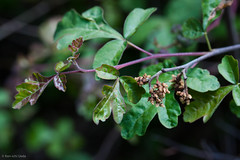
|
Skunkbush Sumac, Rhus aromatica (Anacardiaceae) |
|

|
Smooth Sumac, Rhus glabra (Anacardiaceae) (hairless) on leaves and stems; leaves turning yellow or red in the fall. Common on hills and gullies. |
|
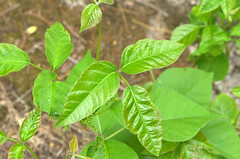
|
Poison Ivy, Toxicodendron rydbergii (Anacardiaceae) |
|

|
Wild Carrot, Daucus carota (Apiaceae) |
|

|
Cow Parsnip, Heracleum sphondylium (Apiaceae) Tall herbaceous species to 7' tall with pubescent stems; leaves large, compound and with stalked leaflets that are coarsely toothed; inflorescence of compound umbels, white flowers; ovate fruits that are dorsally flattened and 1 cm long; common in marshy wet soils across South Dakota, leaf sap contains furocoumarins responsible for phototoxicity. |
|

|
Threadleaf Musineon, Musineon tenuifolium (Apiaceae) Low growing perennial herb, taprooted, with very little aboveground stem; leaves highly divided into linear segments only 1 mm or so wide and up to 10 cm in length; umbels of numerous yellow flowers, an inch or more across and above leaves at fruiting stage; common from low to high elevations in open forest and grassland with rocky soils; only found in Black Hills and adjoining areas of other states. |
|
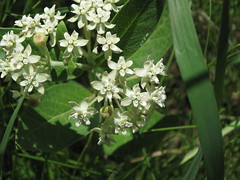
|
Dwarf Milkweed, Asclepias pumila (Asclepidaceae) |
|

|
Wild Yarrow, Achillea millefolium (Asteraceae) Rhizomatous perennial with finely divided and fernlike leaves in alternate arrangement; foliage aromatic when crushed; flower heads white and in corymb arrangement. |
|

|
Western Ragweed, Ambrosia psilostachya (Asteraceae) |
|

|
Dwarf Sagebrush, Artemisia cana (Asteraceae) |
|

|
Pasture Sage or Lady Sage, Artemisia frigida (Asteraceae) |
|

|
White Sage, Artemisia ludoviciana (Asteraceae) |
|

|
Smooth Blue Aster, Aster laevis (Asteraceae) Stems and leaves glaucous; foliage leathery; leaves sessile; bases clasp stem, but do not fully encircle it; leaves lanceolate to narrowly ovate, highly variable in length; heads several to numerous in panicle- like arrangement; rays blue or purple; common in open forests and meadows in the Black Hills. |
|

|
Few-flowered Aster, Aster pauciflorus (Asteraceae) Perennial herbs with clumped stems from a rhizome; leaves linear, up to 5 cm long and less than 5 mm wide; inflorescence few flowered, heads solitary on corymbose branches; involucre bracts glandular, ray flowers blue to pink and to 2 cm across; uncommon in dry or alkaline soils in w South Dakota. |
|

|
Goldaster, Chrysopsis villosa (Asteraceae) Perennial herbs, multiple stems from a taproot, up to 2' tall with dense spreading hairs; many small leaves (<2" long), elliptical; several flower heads per stem in corymb, involucres up to 0.5" tall and 1" across; florets yellow, ray florets with large yellow petals, attractive and showy; common in prairie and open sandy habitats across South Dakota. |
|

|
Purple Coneflower, Echinacea angustifolia (Asteraceae) |
|

|
Joe Pye Weed, Eupatorium maculatum (Asteraceae) Perennial of wet habitats (riparian areas, ditches, seeps, etc.) up to 7' tall; lanceolate leafs with coarse tooths in whorls of 4-5; flower heads purple to pink in flat-topped corymb. |
|

|
Gumweed, Grindelia squarrosa (Asteraceae) |
|

|
Matchbush, Gutierrezia sarothrae (Asteraceae) |
|

|
Common Sunflower, Helianthus annuus (Asteraceae) |
|

|
Dotted Blazing Star, Liatris punctata (Asteraceae) |
|

|
Canada Goldenrod, Solidago canadensis (Asteraceae) Perennial herb to 4' in height, stems single or in loose clusters; stem pubescent with sessile leaves that are lanceolate to elliptic, ranging from entire to serrate, and 3-nerved; inflorescence in a terminal panicle, most of flower heads on upper side of branches; a highly variable taxon (there are four varieties in the Black Hills region), this is a native species that is sometimes weedy. |
|

|
Rigid Goldenrod, Solidago rigida (Asteraceae) Perennial herb with unbranched and stout stems; leaves pubescent, ovate to lanceolate and relatively broad; lower leaves substantial and persistant, upper leaves smaller and ovate; flowers yellow and in a "congested corymb" so as to be somewhat flat-topped. |
|

|
Tansy, Tanacetum vulgare (Asteraceae) Perennial plants with spreading rhizome, growing to 6' tall; large leaves that are highly divided (but less so than wild yarrow-- larger segments) and aromatic; flower heads yellow and in corymbiform cymes. Native to Eurasia, now naturalized and sometimes invasive. |
|

|
Dandelion, Taraxacum officinale (Asteraceae) yellow, with wind-dispersed seeds. Common in lawns and waste area, rare in natural habitats. |
|

|
Yellow Goatsbeard, Tragopogon dubius (Asteraceae) Annual or biennial herbaceous weed with basal and stem leaves, linear and lacking milky sap; yellow flower heads with wind-dispersed seeds (much large than Dandelion). Common in waste areas and prairies in the Spearfish area. |
|
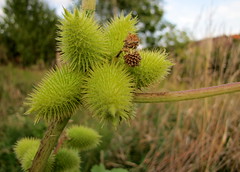
|
Cocklebur, Xanthium strumarium (Asteraceae) Annual weed, up to 5' tall and often branched; leaves alternate, large, ovate and irregularly lobed; flower heads unisexual, males about females; involucre becomes bur with horned prickles. North American origin, now naturalized widely in northern hemisphere. |
|

|
Soapweed, Yucca glauca (Agavaceae) |
|
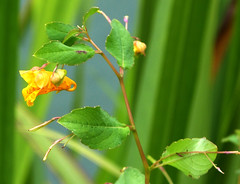
|
Spotted Touch-Me-Not, Impatiens capensis (Balsaminaceae) Annual plant with smooth stems and branches up high; flowers on drooping pedicels, yellow-orange flowers with red/brown spots, conspicuous spurred sepal, fruits that expode. Likes wet places, has long growing season that extends into fall. |
|

|
Oregon Grape, Berberis repens (Berberidaceae) |
|

|
Japanese Barberry, Berberis thunbergii (Berberidaceae) |
|

|
Paper Birch, Betula papyrifera (Betulaceae) Trees with characteristics white, papery bark at maturity (younger stems brown-red with white lenticels); leaves ovate, simple, alternate, doubly serrate; cold loving tree and pioneer species in northern regions, it is common in Black Hills but near the southern-most edge of its range. |
|

|
Hop Hornbeam, Ostrya virginica (Betulaceae) Small tree, bark rough and scaly; leaves alternate, double serrate, leaves ovate; common in moist woods and ravines in Black Hills region. Very hard wood, useful for posts, longbows, and similar applications. |
|

|
Foxtail Cactus, Coryphanta missouriensis (Cactaceae) |
|

|
Little Prickly Pear, Opuntia fragilis (Cactaceae) Cactus with finger-like stems (not so flattened as O. polyacanta), weakly jointed and tending to separate easily as means of dispersal; wooly areoles with several spines each. |
|

|
Plains Prickly Pear, Opuntia polyacanta (Cactaceae) |
|

|
Bellflower, Campanula rapunculoides (Campanulaceae) |
|

|
Great Blue Lobelia, Lobelia siphilitica (Campanulaceae) Perennial herb with upright stems, common in wet soils (stream and pond margins, ditches, etc.) across South Dakota; stems to 3' tall, leaves to 5" long, obovate with decurrent bases; flowers blue and bilaterally symmetric, showy and pollinated by bumble bees. |
|
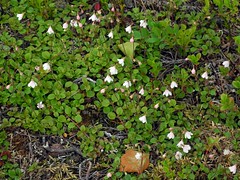
|
Twin Flower, Linnaea borealis (Caprifoliaceae) Perennial subshrub with stems to 1.5 feet; evergreen leaves oval and opposite; white-pink flowers fused in pairs on axillary peduncles; favorite plant of Carl Linnaeus, this plant is monotypic and has a circumpolar distribution; common in rich woods on ravines and hillsides in the Black Hills. |
|

|
Snowberry, Symphoricarpos albus (Caprifoliaceae) Branched and shrubby plant to 3' tall; leaves generally <1" in length, opposite, ovate and entire; flowers small and becoming white berry to 1 cm diameter; in Black Hills and relatively cool/shady sites in South Dakota, less common than wolfberry in general. |
|

|
Wolfberry, Symphoricarpos occidentalis (Caprifoliaceae) white or pink flowers often paired, fruits white and standing out in the fall season. |
|

|
Bittersweet, Celastrus scandens (Celastraceae) Woody vine to 10-15' and clambering over trees; leaves elliptic to ovate with acuminate tips, alternate arrangement; flowers green and becoming yellow-orange fruits. Occurs in woods and riparian areas across the state. |
|

|
St. John's Wort, Hypericum perfoliatum (Clusiaceae) Perennial weed that forms dense patches; stems persistent and stiff well past flowering, up to 3' tall; leaves oblong with rounded bases; yellow flowers (up to 1" across) in terminal inflorescences; fruits are capsules. |
|
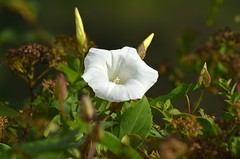
|
Field Bindweed, Convolvulus arvensis (Convolvulaceae) Creeping perennial native to Eurasia, now pernicious weed in open habitats of the U.S. and Canada; rumpet shaped flowers up to 1" in diameter, white or pinkish. Can form dense mats in waste areas. |
|

|
Wormleaf Stonecrop, Sedum lanceolatum (Crassulaceae) |
|

|
Common Juniper, Juniperus communis (Cupressaceae) Coniferous evergreen shrub, generally 3' tall or less, often formatting mats; leaves in whorls of 3, dark green on one side and white on the other; berry-like female cones. Very widespread across Northern Hemisphere, largest range of any woody plant species. |
|

|
Creeping Juniper, Juniperus horizontalis (Cupressaceae) Coniferous evergreen shrub that is low-growing (generally <1' tall); leaves are scale-like and appressed to the stem (in young seedlings, leaves are needle-like); known to hybridize with Rocky Mt. Juniper and Eastern Juniper. |
|
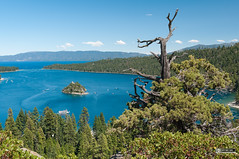
|
Eastern Juniper aka Red Cedar, Juniperus virginiana (Cupressaceae) Upright shrub to large tree; leaves scale-like (a la Juniperus horizontalis) appressed to branches, tending to overlap and have acute tips; usually dioecious, cones mature into a berry-like structure; species principally with an eastern North American distribution, near the edge of its range in Black Hills region; hybridizes with Rocky Mt. Juniper and Creeping Juniper. |
|

|
Russian Olive, Elaeagnus angustifolia (Elaeagnacaea) Shrub to small tree, usually branched; lanceolate leaves with silver-grey pubescence; small yellow flowers. Commonly cultivated-- including for windbreaks on the prairie-- and escaped in low lying and wet habitats across South Dakota; despite the name, not closely related to olives (Oleaceae). |
|
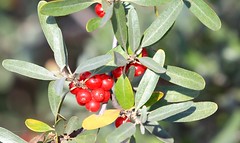
|
Buffaloberry, Shepherdia argentea (Elaeagnaceae) Deciduous shrub or small tree to 15' in height, armed with thorns; leaves opposite, small (to 2.5" long) and oval and covered with silky silver hairs, especially underneath; flowers pale yellow, fruits are bright red fleshy drupes, edible but bitter; sometimes cultivated (including yellow fruited forms). Important food for wildlife (berries and foliage) especially in more northerly parts of its range; historically eaten by Native Americans in parts of the range (raw, dried, as sauce for meat). |
|
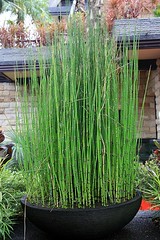
|
Scouring Rush, Equisetum hyemale (Equisetaceae) Tall and robust stems (approaching pen thickness and tough) >15 cm tall (often 3' or more); stems rough to touch, perennial, and evergreen; nodal areas black and lacking whorls of leaves; substantial nodal sheath that is brown-grey; strobili tipped with sharp spines; common in moist soils across South Dakota. |
|

|
Dwarf Scouring Rush, Equisetum scirpoides (Equisetaceae) Short and very slender stems (almost hairlike, but tough) <15 cm tall and generally consistent in size; nodes black and lacking whorls of leaves; small strobuli; marshy wet soils at mid- to high elevations in the Black Hills (and widespread but scattered across Northern Hemisphere); used as a decorative plant. |
|

|
Bearberry or Kinnikinnick, Arctostaphylos uva-ursi (Ericaceae) Creeping and often branched woody shrub to 30 cm tall; thick evergreen leaves in alternate arrangement, up to 1" in length, bright green and hairless; flowers white-pink, urn-shaped and with joined petals; red berries to 1 cm diameter; in Black Hills at mid- to high-elevations on slopes and rocky areas; very widespread species in general (North America, Europe, Asia). |
|

|
Pipsissewa, Chimaphila umbellata (Ericaceae) Low-growing evergreen perennial with naked flowering stems; sharply serrate leaves whorled to opposite; flowers pink, nodding, with five petals; fruits a capsule; rare in rich pine woods at higher elevations; leaves used in tobacco mixes and to treat eye inflammations and urinary infections. |
|

|
Lead Plant, Amorpha canescens (Fabaceae) |
|

|
Licorice, Glycyrrhiza lepidota (Fabaceae) Perennial herb with upright stems, sparsely branched; leaves pinnately compound with 11-19 leaflets; flowers white, fruits approaching 1" in length, dark brown, covered in spiny hooks. Common in dry meadows and forest margins. |
|

|
Black Medic, Medicago lupulina (Fabaceae) Annual with stems pubescent and prostrate; leaves compound (trifoliate) with serrations that are often subtle; flowering head small and globose with yellow flowers, maturing to black fruiting pods; native to Eurasia, frequently weedy in South Dakota; nitrogen fixer that can be used as a cover crop; poor forage; same genus as alfalfa, leaves easily confused with Trifolium. |
|
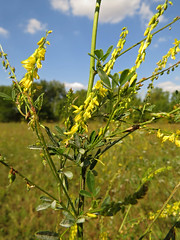
|
Yellow Sweetclover, Melilotus officinalis (Fabaceae) racemes to 5" long; very common in roadsides, fields, and grazed areas in western South Dakota. |
|

|
Red Clover, Trifolium pratense (Fabaceae) Herbaceous perennial; leaves trifoliately compound with a pale white crescent; flowering head globuse with a pubescent calyx tube; flowers purple and sessile; native to Europe and Asia but widely planted in North America as a cover crop (nitrogen fixer); also used for hay. |
|

|
Bur Oak, Quercus macrocarpa (Fagaceae) In Black Hills on forest margins at lower elevations, relatively small tree; deeply lobed leaves with rounded lobes; fringed involucre on acorns. Drought tolerant, long taproot, fire resistant. |
|

|
Wild Black Currant, Ribes americanum (Grossulariaceae) Unarmed woody stems to 5' tall; leaves lobed (3-5 lobes), coarsely toothed, and sizable (up to 3-4" across), lower surface with resinous dots (yellow to orange in color); fruits black and smooth; common in wood across South Dakota, used for jams and jellies, and now introduced to China. |
|

|
Gooseberry, Ribes missouriense (Grossulariaceae) |
|

|
Dudley Rush, Juncus dudleyi (Juncaceae) |
|

|
Bergamot, Mondarda fistulosa (Lamiaceae) |
|

|
Catnip, Nepeta cataria (Lamiaceae) |
|

|
Canada Mayflower, Maianthemum canadense (Liliaceae) Short perennial herb with two forms: 2-3 leaves with flowering stem (3-6 cm) or 1 leaf with no flowering stem; blades ovate to cordate with prominent veins; inflorescence a short raceme of white flowers with four tepals and stamens; fruits translucent red. Common in rich woods, often spreads vegetatively by rhizomes. |
|

|
Clubmoss or Ground Pine, Lycopodium obscurum (Lycopodiaceae) Creeping rhizomatous perennial, produces evergreen aerial shoots with dichotomous branching that is reminiscent of a very young spruce or pine tree; up to 1' in height with straight-up stems; leaves small and crowded on stems; sporophylls tan and very different than green vegetative parts of the plant; infrequent to rare in Black Hills at mid- to high-elevations. |
|

|
Green Ash, Fraxinus pennsylvanica (Oleaceae) Canopy tree species; compound (pinnate) opposite leaves, eliptical in shape, serrate margins, pinnate veination, 7-9 leaflets per leaf; common in Black Hills natural areas, also planted around buildings; faces major threat now from the emerald ash borer. |
|

|
Panicled Willow Herb, Epilobium paniculatum (Onagraceae) Annuals with branching stems, generally glabrous; leaves narrowly lanceolate with small teeth; flowers light pink, small, becoming 1-2" capsules that split at maturity; common in sandy soils in wet areas and forest margins. |
|

|
Evening Primrose, Oenothera biennis (Onagraceae) |
|
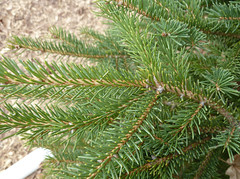
|
Black Hills Spruce or White Spruce, Picea glauca var. densata (Pinaceae) Evergreen tree with pyramid shaped crown; bark is thin, scaly; needles small (2 cm long or less), square or rhomboid in cross-section, painful to touch (hence "ouch test" for distinguishing spruce from fir), green to blue-green in color; pendulous female cones with papery scales; cold-loving tree, it is common in Black Hills (mid- to high elevation) but near the southern-most edge of its range. |
|

|
Ponderosa Pine, Pinus ponderosa subsp. scopularum (Pinaceae) Canopy tree and very common in Black Hills region; mature specimens have orange-red bark with black crevices; bright green needles in fascicles of 2-3, needles 10-12 cm in length (shortest of the Ponderosa Pine subspecies). |
|

|
Common Plaintain, Plantago major (Plantaginaceae) |
|

|
Crested Wheat Grass, Agropyron cristatum (Poaceae) natural areas (dry prairie). |
|

|
Big BlueStem, Andropogon gerardii (Poaceae) |
|

|
Smooth Brome, Bromus inermus (Poaceae) |
|

|
Sideoats Gramma, Bouteloua curtipendula (Poaceae) |
|

|
Orchard Grass, Dactylis glomerata (Poaceae) Rhizomatous perennial with long, flat leaves; stems to 4' tall with terminal inflorescence of characteristic shape; idely cultivated as forage, sometimes escaping or persisting in natural areas. |
|

|
Kentucky Blue Grass, Poa pratensis (Poaceae) |
|

|
Little Bluestem, Schizachryium scoparium (Poaceae) |
|

|
Yellow Foxtail, Setaria glauca (Poaceae) Short grass; inflorescence dense and resembles a foxes tail; weed of roadsides + disturbed areas. |
|

|
Indian Grass, Sorghastrum nutans (Poaceae) Tall-statured bunch grass (up to 7’), generally unbranched stem with reddish-golden color; dense terminal inflorescence; native grass of South Dakota prairies, still common. |
|

|
Prairie Cord Grass, Spartina pectinata (Poaceae) |
|
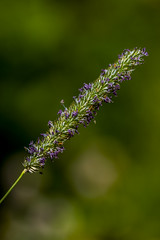
|
Timothy, Phleum pratense (Poaceae) Mid-sized grass (to 3') grass with a cylindrical, dense inflorescence; introduced from Europe by colonists but not aggressive; very widely planted for forage, commonly used for hay but can used in pastures; often main food for “pocket pets.” q |
|
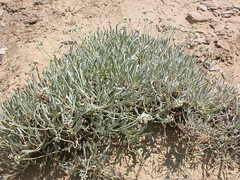
|
Few-Flowered Buckwheat, Eriogonum pauciflorum (Polygonaceae) Perennial with woody rootstocks, usually growing in dense clusters; basal leaves small, forming at crown of caudex; flowers in dense heads to 0.5" across, white to rose colored; common in dry sandy prairie in western South Dakota. |
|

|
Smartweed, Polygonum amphibium (Polygonaceae) |
|

|
Fragile Fern, Cystopteris fragilis (Polyploidiaceae) Low-growing fern, fronds usually 1' or 1.5' in length from creeping rhizome, leaves 1-3x pinnate and glabrous, basal pinnae slightly shorter than the second pair of pinnae; ultimate leaf segments usually toothed or cleft; sori on underside of leaves |
|

|
Shield Fern, Dryopteris filix-mas (Polypodiaceae) Large fern with fronds up to 3' in length; scaly rhizomes and leaf stalks (orange-brown scales); leaves semi-evergreen, twice-pinnatifid and ultimate segments (pinnules) serrate; sori in two neat rows, closer to the midvein then the leaf margin; in moist, rocky woods of the Black Hills, but has very large overall geographic distribution (including Europe). |
|

|
Fringed Loosestrife, Lysimachia ciliata (Primulaceae) Stems branched but upright to 3' tall; leaves opposite, ovate to lanceolate in shape and with ciliate petioles; small numbers of flowers on axils, capsules maturing with persistent sepals; occurs along creeks/streams and in wet soil across South Dakota. |
|

|
Candle Anemone, Anemone cylindrica (Ranunculaceae) Herbaceous plants to 3' tall with basal and cauline leaves that are highly lobed to dissected and distinctive in shape; flowers white-green, 1 to several per stem, become cylindrical fruits up to 2" long; achenes are cottony fuzz that permit wind-dispersal. |
|

|
Western Virgin's Bower, Clematis ligusticifolia (Ranunculaceae) Vines (often on fences or clambering over trees) with pinnately compound leaves (5-7 leaflets); leaflets small and coarsely toothed; flowers white in clusters of 2-3 and in axillary panicles, developing feathery beaks (sometimes >1") at maturity. |
|

|
Purple Meadowrue, Thalictrum dasycarpum (Ranunculaceae) |
|

|
Early Meadowrue, Thalictrum dioica (Ranunculaceae) Perennial herb with branches low on plant, generally 2' or less in height (vs. T. dasycarpum, which is taller); compound leaves with toothed leaflets, usually 3 lobes per leaflet; plants dioecious, wind pollinated. |
|

|
Agrimony, Agrimonia striata (Rosaceae) Perennial herbs to 1 m in height, stems pubescent especially at top; leaves pinnately compound with 5- 11 toothed leaflets; flowers terminal on inflorescence, yellow, becoming bristly fruit (multiple rows of hooked bristles). Common in forest openings in Black Hills. |
|

|
Hawthorn, Crataegus succulenta (Rosaceae) Shrub or small trees with conspicous thorns; leaves simple, alternate, broadest towards the middle and ovate in shape, and becoming glabrous; fruits are pomes, red, and resemble miniature apples; common in ravines and wooded banks. |
|

|
Wild Strawberry, Fragaria virginiana (Rosaceae) Perennial herb with stolons; compound leaves with three leaflets (trifoliate), toothed margins; terminal tooth of terminal leaflet shorter than adjacent teeth (distinguishes vs. F. vesca); flowers white and in cymes, becoming red aggregate fruits (strawberries). Common forest species. |
|

|
Sulfur Cinquefoil, Potentilla recta (Rosaceae) Perennial herb; pubescent (both long and short hairs—short hairs may be glandular); palmately divided leaves with 5-9 sharply toothed leaflets; flower yellow; introduced from Europe and become weedy in parts of the Rocky Mountains. |
|

|
Choke Cherry, Prunus virginiana (Rosaceae) Common shrub or small tree on hills and gullies; simple alternate leaves that are elliptic or lanceolate and smooth on lower surface; extrafloral nectaries present on petioles (usually small nectaries for this species); white flowers becoming red fruits. |
|

|
Prairie Rose, Rosa arkansana (Rosaceae) |
|

|
Western Wild Rose, Rosa woodsii (Rosaceae) Tall statured shrubs (to 6' tall) of forests and hillsides; stems with prickles that are sparsely distributed (compared to prairie rose) but often present by stipules;l eaves pinnately compound with 7-9 leaflets; flowers <2 cm across, becoming red fruits. |
|

|
Thimbleberry, Rubus parviflora (Rosaceae) Perennial herb to shrub >1m tall; no thorns on stems (vs. many other species in the genus); simple leaves, lobed, and very large (almost maple-like); large pink flowers becoming red fruits, relatively dry for the genus. Common mid- to high elevations in Black Hills. |
|

|
White Spiraea, Spiraea betulifolia (Rosaceae) Low-growing rhizomatous shrub with thin stems, mostly erect, with few or no branches; bark smooth, red-brown, often exfoliating near the base; leaves simple and alternate, coarsely toothed to irregularly lobed at their end; many small white flowers, 5-petaled, in dense flat-topped clusters at the end of stems; common in the Black Hills in mid- to high- elevations. |
|

|
Northern Bedstraw, Galium boreale (Rubiaceae) Perennial herbs on slopes and forested gullies; leaves small, whorled in sets of four; plant mostly hairless; flowers small and white, 4-merous. |
|

|
Sweet Scented Bedstraw, Galium triflorum (Rubiaceae) Spreading perennial herb without stiff, dense hairs (vs. G. aparine); leaves six or more per whirl with pointed tips; flowers green to white, small, becoming pubescent fruit. Common in woods and thickets across South Dakota. |
|

|
Quaking Aspen, Populus tremuloides (Salicaceae) Small to mid-sized tree with smooth whitish bark that can be confused with paper birch; simple alternate leafs, that are serrulate (very small teeth), flat petioled, oval-shaped; highly clonal in some areas (represents "largest living organism" in parts of the Rocky Mountains); fast growing pioneer species, widespread across North America. |
|

|
Eastern Cottonwood, Populus deltoides (Salicaceae) Canopy tree that favors riparian habitat; chunk bark that is characteristic of the species; leaves simple , alternate, serrated with rounded teeth, deltoid shape with tip; One of largest trees found naturally in vicinity of Spearfish. |
|

|
Willow, Salix sp. (Salicaceae) Woody shrubs and sometimes trees; often have linear leaves; flowers are catkins; dioecious; often hybridize and can be difficult to identify; found in wet habitats, often spread clonally; ecologically important as wildlife food/cover and as stream bank stabilizers; leaves contain salicylic acid (aspirin). |
|

|
Alum Root, Heuchera richardonii (Saxifragaceae) |
|

|
Mullein, Verbascum thapsus (Scrophulariaceae) |
|

|
Brooklime, Veronica americana (Scrophulariaceae) Herbaceous perennial found in streams and very wet soils, sometimes weedy; plant glabrous, leaves entire or nearly so; inflorescences in axils of upper leaves; flowers light blue with peculiar shape, 2 fertile anthers. Edible as a green (though beware polluted water). |
|

|
Carrion Flower, Smilax herbaceae (Smilacaceae) |
|

|
Buffalo Bur, Solanum rostratum (Solanaceae) Annual with very prickly stems that are branched; low growing with a sprawling habit; pinnately lobed leaves, yellow flowers (5 petals) up to 1" across, calyx inflated and very spiny. Common in waste areas, also an indicator species of overgrazing. Original host of Colorado Potato Beetle. |
|

|
Broad Leaved Cattail, Typha latifolia (Typhaceae) Tall perennial monocot (to 7' tall) common in marshy soil across South Dakota; leaves flat, long, to 1" in width; flowers in characteristic spike, brown, with pistillate and staminate parts. Very widespread spp. (South America, Europe, Asia, Africa) that is a weed of Australia and some Pacific Islands. Edible plant (rhizomes can be cooked, stems and young flowers can be eaten raw). |
|

|
American Elm, Ulmus americana (Ulmaceae) Canopy tree sometimes growing to 100' tall; leaves large with acuminate tips and doubly serrate margins and uneven leaf bases; leaf blade may feel scratch to touch (also true of Ulmus rubra); common in riparian areas and cultivated, but now heavily impacted by Dutch Elm Disease. |
|

|
Hoary Vervain, Verbena strica (Verbenaceae) Plant upright to 3' tall with terminal spikes (1-3 per stem); leaves softly pubescent, ovate, and coarsely toothed; flowers range from white to purple; very common in disturbed habitats across South Dakota. Not-palatable to livestock. |
|

|
Riverbank Grape, Vitis riparia (Vitaceae) Perennial vines sometimes reaching canopy level; leaves lobed (3-5 lobes each) and serrate, though variable depending upon microenvironment; fruits smooth and purple, up to 1 cm in diameter, 1-3 seeds each; common plant on forest margins across South Dakota. |

